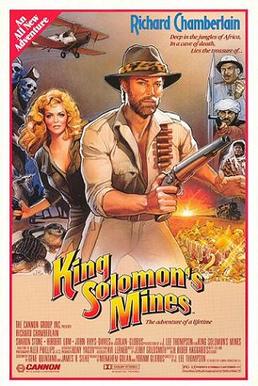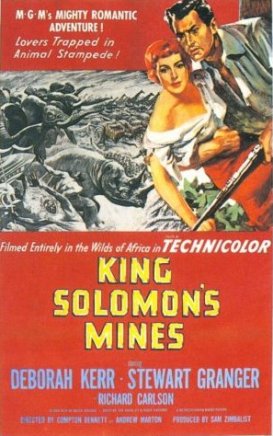 After her archaeologist father disappears while searching for the fabled mines of King Solomon, Jesse Houston (Sharon Stone) hires famed explorer Allan Quartermain (Richard Chamberlain) to help her find him. After walking around in the jungle and exploring a nearby village, Allan and Jesse discover that her father has been kidnapped by a German military expedition who want to use King Solomon’s treasure to fund their war effort. Working with the Germans is Allan’s old enemy, Dogati (John Rhys-Davies). Allan and Jesse find themselves in a race against time to find the mines before the Germans. Along the way, they steal an airplane, fight German soldiers on a train, and nearly get cooked alive in a giant cauldron.
After her archaeologist father disappears while searching for the fabled mines of King Solomon, Jesse Houston (Sharon Stone) hires famed explorer Allan Quartermain (Richard Chamberlain) to help her find him. After walking around in the jungle and exploring a nearby village, Allan and Jesse discover that her father has been kidnapped by a German military expedition who want to use King Solomon’s treasure to fund their war effort. Working with the Germans is Allan’s old enemy, Dogati (John Rhys-Davies). Allan and Jesse find themselves in a race against time to find the mines before the Germans. Along the way, they steal an airplane, fight German soldiers on a train, and nearly get cooked alive in a giant cauldron.
Because this is a Cannon film and it was made at the height of Indiana Jones’s popularity and it stars John Rhys-Davies and it has a score that sounds like it was written by someone trying too hard to be John Williams, you might be tempted to think that King Solomon’s Mines is a rip-off of Raiders of the Lost Ark. However, there are some crucial differences between Raiders and King Solomon’s Mines. For instance, Raiders of the Lost Ark took place during World War II. King Solomon’s Mines takes place during World War I. Raiders of the Lost Ark had angels that melted a man’s face. King Solomon’s Mines has a lava pit that makes you explode if you fall into it. Raiders of the Lost Ark has a big fight in an airfield while King Solomon’s Mines has a big fight at an airfield …. well, wait, I guess they do have a few things in common.
Probably the biggest difference between Raiders of the Lost Ark and King Solomon’s Mines is that Raiders had Harrison Ford and Karen Allen while King Solomon’s Mines has to make due with Richard Chamberlain and Sharon Stone. (If the imdb trivia section is to be believed, Sharon Stone was cast because Menahem Golan mistook her for Kathleen Turner.) Along with generating zero romantic sparks, neither Chamberlain nor Stone come across as if they’ve ever even seen a jungle, much less explored one. The only time that the two of them are credible as anything other than actors slumming on Cannon’s dime is when they’re yelling at each other. There’s also a scene where they’re trying to steal an airplane and Chamberlain tells Stone to “reach between your legs and grab it.” That was funny, I guess.
Along with trying to be an adventure, King Solomon’s Mines also tries to be a comedy. As a general rule, Cannon films are great when they’re unintentionally funny but not so much when they actually try to be funny. The film’s idea of comedy is Richard Chamberlain having to do an impromptu jig while someone shoots at his feet. Add in a healthy dose of casual racism as Allan and Jesse run into a tribe in Africa who want to cook them in a giant stew pot and you’ve got a film so bad that you’ll hardly believe it could have been produced by the same people who gave us Delta Force, which is, of course, the greatest film ever made.
Golan and Globus had enough confidence in King Solomon’s Mines that they shot a sequel before the first film was even released. Tomorrow, I will force myself to watch and review Allan Quartermain and The Lost City of Gold. And, after that, I’ll probably go sit in a corner and think about what I’ve done.
